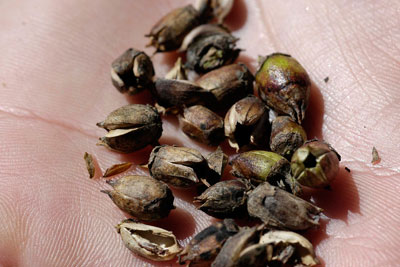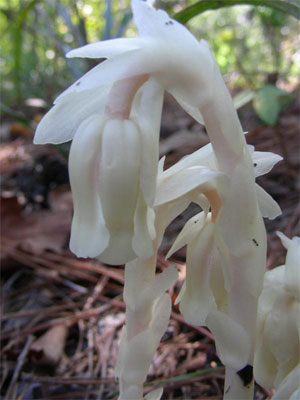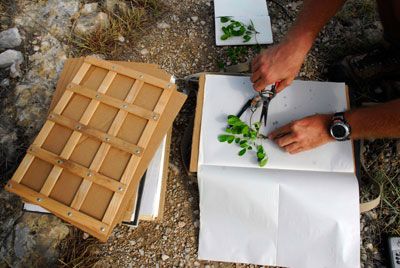Saving Texas Landscapes
IF YOU DIDN’T KNOW ANY BETTER, you might think Michael Eason and Minnette Marr were a bit obsessed with their jobs.
Consider the nine months a year they spend criss-crossing Texas to hunt down button cactus, smooth beggartick and other plants when their fruit are just getting ready to unleash their seeds; that their vehicles are stuffed full of hiking gear, plant lists, tree pruners and empty seed envelopes; or that their weekends and evenings are more likely spent on the road or planning future seed-collecting trips than with family and friends.

Ask either of them, though, and home is where they long to be. “You really have to love plants a lot – love the reason you’re doing this, or you’d never keep going,” says Marr, who with Eason and 100-plus volunteers at the Wildflower Center helped create a seed collection that just hit the record books.
Since 2000, the two full-time staff for the Millennium Seed Bank Project and their counterparts in the U.S. and 53 other countries have gathered seeds for posterity from more than 24,000 of the world’s wild flowering plants. Achieving that goal has sometimes required climbing rocky slopes in West Texas to identify angel’s trumpets as their tiny white flowers open in the cool evening air, searching for devil’s head cactus in triple-digit temperatures in the Chihuahuan desert and wading through East Texas bogs to reach pitcher plants resembling calla lilies. Along the way, they’ve dealt with rattlesnake strikes, the smell of javelinas walking by their tents at night and armies of mosquitoes and other bugs.
What they’ve gained is a chance to see the diverse native landscapes of Texas, where nearly a quarter of the native plant species in America live. Like birders sighting new species, they sometimes also discover plants they haven’t run across before, an easier trick to do than with animals.
“There are more than 6,000 species of native Texas plants, and there are only two species of deer,” Eason says with awe. “The first time you see something like an Indianpipe plant, it’s pretty amazing.”
Stack that sense of wonder next to the tenuous hold some plants have on the landscape, and you understand what motivates seed collectors like him.

In the United States overall, about one in five native plant species are threatened with extinction. In Texas, home to the first plant placed on the Endangered Species List, 23 endangered and five threatened plant species in total cling to life. For another 200-plus species, there’s just not enough known because of resource constraints to make informed decisions about their conservation.
“Some of the plant populations I collected in the beginning, when I go back, there’s a housing development or a strip mall there now,” Eason says. “That population is gone forever.”
That knowledge fueled the 600 collecting trips Eason and Marr have completed since 2002, when the Wildflower Center at The University of Texas at Austin became the first nongovernmental organization of the Project led by the Royal Botanic Gardens, Kew. During the Millennium Seed Bank Project’s first phase that ends this year, they’ve created a nest egg of 10,000 to 20,000 seeds from 590 native plants in the state. A Center goal of collecting seeds from an additional 800 or so species has been set for the project’s next decade.
“We’re not looking for the tallest plant or the one with the prettiest flower in a population,” Marr notes. “We’re looking for as much diversity in populations as we can because we’re not sure how people are going to use these seeds in the future.”
The targets are commonplace plants, including flagship species such as the Texas bluebonnet, species indigenous people value and those that can out-compete harmful plants that aren’t native to a region. The collections even include common species that might cause some to turn up their noses, such as giant ragweed, since they all form part of the interdependent mosaic of nature.
“It’s not as sexy as focusing on plants that are about to blink out of existence, but it’s smart,” says Flo Oxley, director of education and conservation at the Wildflower Center, who oversees the Center’s work in the Millennium Seed Bank Project.
“We’re focusing on the plants that form the foundation of landscapes — the plants that wildlife and other plants, particularly endangered plants, need to have on hand to survive.”
Dozens of volunteers from around Houston, Dallas, El Paso and elsewhere have helped Eason and Marr out in the field with the detailed task of finding plants during the sometimes short windows of time when their seeds can be collected. Once the seeds are bagged up, dozens of other volunteers back at the Wildflower Center clean them further before they are frozen to minus 4 degrees Fahrenheit to stay viable for what could be centuries.
“The work is very labor intensive, but very rewarding,” says Al Ohm, a retired lawyer in Austin who began volunteering this year to clean seeds with his wife, Jean Ohm, a retired school teacher. “To think that they may take these seeds I’ve cleaned and sealed into airtight bags and open them up 300 years from now – that’s kind of exciting.”
“It’s unfortunate that people don’t know that we’re close to plant species becoming extinct that we don’t even know about,” Ohm adds. “You go up the food chain, and eventually you get to us.”

Compared to states such as California, Texas has few large swaths of land set aside in a pristine state. More than 90 percent of Texas is in the hands of private landowners such as cattle ranchers who have been hit by hard by the recent drought, and may have to consider selling to developers or others in the future.
Some landowners have set aside bits and pieces of land in Central Texas and elsewhere as wildlife habitat, but not enough to offset development, so that Eason and Marr can easily envision their work feeding into landscape restoration projects in the future.
“There’s always been a restoration aspect to the Millennium Seed Bank Project” Eason says, “but now I think people are realizing more clearly that there’s just not enough native plants out there, there’s just more of a need for having restoration as a priority”
A case in point, he notes, is the fragile dune ecosystems near Galveston Island. These dunes are buffeted by winds under normal circumstances. They were also hit hard by Hurricane Ike, which tore out some vegetation and left the remnants to choke under several feet of saltwater. “We’ve collected the bulk of the primary plant species in this ecosystem,” Eason says.
“As people consider restoring these dunes impacted by development and other factors, we can provide seeds from wild plants like beach morning glory that are integral features of this landscape.”
Millennium Seed Bank Project
To learn more about the Millennium Seed Bank Project here.
In addition to funding from the United Kingdom’s Royal Botanic Gardens, Kew, the Lady Bird Johnson Wildflower Center received grants from the Houston Endowment, Abell-Hanger, and Shield Ayres in support of its MSB collections. The seed collection efforts have also been helped by staff at places that include Sul Ross State University, Mercer Arboretum and Botanic Gardens and the Chihuahuan Desert Research Institute, as well as by private land owners, federal agencies and non-profits such as The Nature Conservancy.

